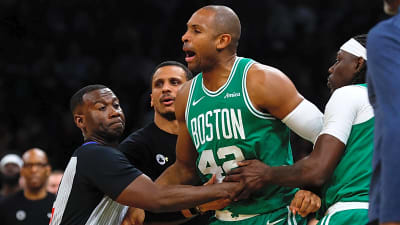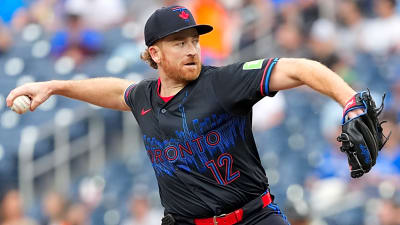
Since the beginning of 2023-24, the Boston Celtics’ offense has been the NBA’s kingmaker. Boston led the league in offensive rating last regular season, finished third during the 2024 playoffs en route to a title and were third this past regular season. Over this prolonged span, few teams have proven capable of slowing the Celtics’ vast, versatile and cohesive machine. It’s a leading reason they entered this postseason with genuine hopes of repeating as NBA champions.
Among those struggling to bottle Boston’s attack includes the New York Knicks, which remade their roster this past summer and shifted from a defense-first identity to an offensive-minded club in 2024-25. They finished 15th in defensive rating against top-10 offenses and were particularly poor during an 0-4 regular season sweep to the Celtics, allowing 135.4 points per 100 possessions (third-worst among all of Boston’s opponents).
Yet through two games of this second-round soirée, New York touts a 2-0 series lead and is limiting Boston to 99.5 points per 100 possessions. A sizable chunk of the Celtics’ offensive foibles stem from uncharacteristically cold 3-point shooting. Between Games 1 and 2, they’ve hit just 25 percent (25-of-100) of their triples, many of which are open, in-rhythm looks for the NBA’s premier group of gunners. But to merely cite shooting variance for Boston’s lackluster offense and 0-2 series hole would be inaccurate. It would be a disservice to New York and its coaching staff, and minimizes the the very real shortcomings of the Celtics’ offensive personnel.
Boston’s Offensive Issues Go Beyond 3-Point Shooting
These Knicks are defending their asses off. Everyone who’s seen rotation minutes deserves some applause. Sure, the Celtics are frigid beyond the arc and there’s some randomness at play. New York is also holding them to 47.3 percent shooting on 2-pointers (57.1 percent in the regular season, third league-wide) and generating a 15.8 percent turnover rate (12.2 percent in the regular season, second league-wide).
Those marks are a whole lot less related to variance and a whole lot more linked to the Knicks’ defensive execution, which has cornered Boston into a singular channel for pursuing reliable offense: the 3-ball. The threes are supposed to open up everything else, not become the only thing when all else craters. The Knicks are refusing to let Boston open those other doors.
By steadily acquiring burly wing after burly wing the past 2.5 seasons, New York built a roster designed to bang with the Boston. The Celtics’ offense thrives on having a bunch of strong, floor-spacing perimeter players who screen well to force mismatches and bend the defense from there.
With OG Anunoby, Josh Hart and Mikal Bridges on the other side, though, leveraging that strength-based creation against the Knicks is far more difficult than the average opponent presents. The Knicks recognize they can neutralize this approach and have elected to shy away from double-teams, trusting their sturdy wing trio to hold it down.
Usually, single coverage would lay the foundation for explosive performances from Jayson Tatum and Jaylen Brown, a pair of talented, punishing scorers who will often etch their way to their spots and flourish against mismatches. Instead, Anunoby, Hart and Bridges are complicating their creation efforts.
Through two games, Tatum is averaging 18 points (39.2 percent true shooting) with 11 assists to eight turnovers while Brown is averaging 21.5 points (43.7 percent true shooting) with six assists to eight turnovers. On the whole, the Celtics’ assist rate has dipped from 62.8 percent in the regular season to 51.5 percent in this series. Those renowned swing-swing-swing or drive-and-kick sequences — often the lifeblood of Boston’s most prolific offensive stretches — have dried up thus far.
But the Knicks are not just leaving dudes on an island and demanding they get the job done without reinforcements. Led by Anunoby, Hart and Bridges, their gap help has been supremely good and impactful. For all their wonderful offensive exploits, the Celtics do not own an elite dribbler of the basketball in their starting five. Each of Tatum, Brown, Jrue Holiday and Derrick White is vulnerable to pestering limbs. New York understands this and has exploited it to interrupt or deter drives.
As a result, Boston trying to do anything downhill or inside the arc looks like it’s wading through velcro. Possessions such as these — not the bricky catch-and-shoot threes — are what should inspire hope the Knicks may nab two more wins and where the Celtics must focus their adjustments.
A Schematic Tweak From New York
Aside from Jalen Brunson — who’s actually competed valiantly on and off the ball to combat Boston’s relentless targeting — the most glaring point of concern for New York’s defense entering this matchup stood at center. While Karl-Anthony Towns’ early returns in the series have ebbed and flowed, Mitchell Robinson’s efforts are anchoring some special possessions. The Knicks are plus-32 during his 43 minutes, featuring an 80.2 defensive rating; Boston’s scored only 69 points when he’s on the floor. Across the 15 minutes he and Towns have shared, they’re plus-21 with a 39.3(!!!) defensive rating.
Robinson’s length, activity and mobility have shut off the interior for the Celtics, which are grappling with New York’s amended ball-screen coverage. After almost exclusively playing drop or at-level coverage in the pick-and-roll all season, the Knicks are switching more than ever with both Towns and Robinson in this series. These numbers are solely from Game 1, but the help reflect how effective and voluminous the new strategy has been.
Pts/direct pick vs those switches
2/8 vs BOS: 1.375
10/25 vs IND: 1.333
1/12 vs MIL: 1.750
12/21 vs NOP: 1.118
1/15 vs PHI: 1.333…
Game 1 vs BOS: 0.762 https://t.co/pWVQ1qVfVz
— Yaya Dubin (@JADubin5) May 6, 2025
The Knicks are consistently disrupting Boston’s offensive flow, whether it be applying ball pressure with Miles McBride, extending out touches as sets unfold or eliminating those perimeter passes the Celtics love pinging around to burn defenses. They’ve even been harmonic whenever Brunson is brought into the spotlight and has to hedge on screens. Rarely are the Celtics comfortably turning the corner with space to pounce. Vacant real estate is hard to come by right now.
Last round, the Detroit Pistons spammed guard-guard screening actions involving Brunson. All those reps seem to have let New York streamline its coverage there, both on the ball and rotating from the backside. It’s emblematic of this group’s continuity. The Knicks are flying around inside, rotating to help the helper and ensuring Boston’s mismatch hunting does not bear the fruit it seeks (shout out to Anunoby, who’s been unbelievably crisp in help). Well-oiled possessions like these illuminate New York’s synergistic defense.
Unlocking the Celtics’ offense may require an uptick in minutes for Payton Pritchard. He’s their most adroit ball-handler and can produce the cleanest paint touches to score or spray kickout passes for open threes as they crave. Like most defenses, the Knicks are not equipped to stymie zippy creators. Pritchard is the zippiest creator Boston offers.
More minutes for Pritchard, however, may come at the expense of Holiday, who’s best qualified to slow Brunson offensively. New York isn’t lighting it up offensively either, though. Is there wiggle room to concede some defensive juice — Pritchard isn’t a massive slouch anyway and White could take aim at Brunson — for smoother offense with Pritchard in Holiday’s stead?
If not, could Luke Kornet siphon some minutes from Boston’s other big men? It’s been tough sledding for both Al Horford and Kristaps Porzingis through two games. Kornet is the Celtics’ best interior play-finisher and their offensive rating is 12.6 points better with him on the court in the series (105.5 vs. 92.9).
He provides a steady release valve from the dunker spot — which Boston desperately needs right now — and can immediately capitalize off of feeds to convert at the rim unlike Porzingis or Horford. The former lacks stability while the latter lacks size and vertical pop. With New York clearly liking the minutes Robinson has given, mirroring their on-court run could be a logical match to keep Kornet near the paint defensively. Or, stash him on Hart, who thrived in Games 1 and 2 but is still liable to instill offensive hurdles for the Knicks.
Boston might not need any rotational tweaks to regain footing. It’s entirely possible the long balls start falling again, the offense levels out and the series tightens up; after all, the margin between these teams is four(!) points through two games. But New York’s defense is not just some passenger watching three after three clank off the rim without any say in why the Celtics are toiling away. These Knicks are connected, shrewd and feisty — and two wins away from the Eastern Conference Finals.
More must-reads:
- Pistons are bringing this former Michigan standout back to the state
- Hawks reloading in suddenly wide-open Eastern Conference
- The 'NBA all-time scoring leaders' quiz
Breaking News
Trending News
Customize Your Newsletter
 +
+
Get the latest news and rumors, customized to your favorite sports and teams. Emailed daily. Always free!








